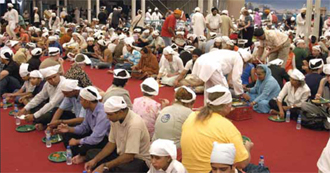Faith and Culture
Sikhism
A Sikh may pray to God directly. No intermediary is needed. Sri Guru Granth Sahib provides all the wisdom and guidance necessary for living a spiritual life, serving as the ultimate guide for Sikhs. Sikhs practice their faith in the Gurdwara, a place of worship, or at home. Each Gurdwara has a Sri Guru Granth Sahib, which anyone is welcome to read. It also has a religious flag (Nishan Sahib) and a community kitchen (Langar).

Sikh woman reading Siri Guru Granth Sahib in her home
While there are Punjabi Americans who are Muslim , Hindu or Christian, the majority are Sikhs. Sikhism is the world’s fifth-largest religion, with nearly 27 million followers. Guru Nanak (1469-1539) founded the religion in the Punjab region of India. Sikhs follow his teachings and those of the nine Gurus who succeeded him. The Sikhs abide by the Shabad (The Word) in the Sikh Scripture, Sri Guru Granth Sahib, and revere it as their living Guru. Sikhism preaches devotion to one God and to remember Him at all times. Sikhs believe in living an honest life and in the equality of all people.

Handwritten page of scripture in Gurmukhi script from Sri Guru Granth Sahib

Sikhs praying at the opening ceremony of Gurdwara in San Jose
Guru Gobind Singh, the tenth Guru, established the order of the Khalsa ("the pure") and commanded them to uphold the highest Sikh virtues of commitment, dedication and social consciousness. The Khalsa are both men and women who choose to go through the initiation (Amrit) ceremony. They follow the Sikh Code of Conduct and maintain five articles of faith called the Five Ks. A Sikh’s goal is to become a Khalsa.

Every Gurdwara has a community kitchen known as Langar. Picture courtesy of wikimedia.org.

Sikh Temple Gurdwara of Yuba City founded in 1969. Picture provided by Ranjit Khandola.
The 5Ks
Initiated (Amritdhari) Sikhs, or the Khalsa, are directed to maintain the five articles of faith: KES, KANGHA, KARA, KACHHEHRA, AND KIRPAN.
- Kangha is a comb that is tucked in the hair. The Khalsa keep their long hair clean and combed, as a matter of self-discipline.
- Kara is a steel bracelet that reminds the wearer of restraint in action, and devotion to God.
- Kirpan is a ceremonial sword. It symbolizes dignity and a commitment to self-defense and to fight against injustice.
- Kachhehra is long underwear worn by both men and women. It is secured around the waist with a drawstring symbolizing self-control and chastity.
- Kes is unshorn hair, a symbol of spirituality and saintliness. Sikhs believe hair is nature’s gift. A turban is worn on the head to cover the hair. Most turban wearing Americans are Sikh.


Weddings
Call them not husband and wife who merely sit together. When two bodies walk on the path to merge into one soul, call them married.Guru Amar Das
A Sikh wedding, called Anand Karaj, marks the joining of the bride and groom in an equal partnership. It is a joyous and festive occasion with religious overtones. Traditionally, family members introduce a suitable partner to their eligible single relative. It is up to the couple involved to make the final decision. More and more young people are choosing their own partners. The ceremony is performed in the presence of Sri Guru Granth Sahib either in a Gurdwara or at the home of the bride, and is followed by a sumptuous meal, music and dance.







